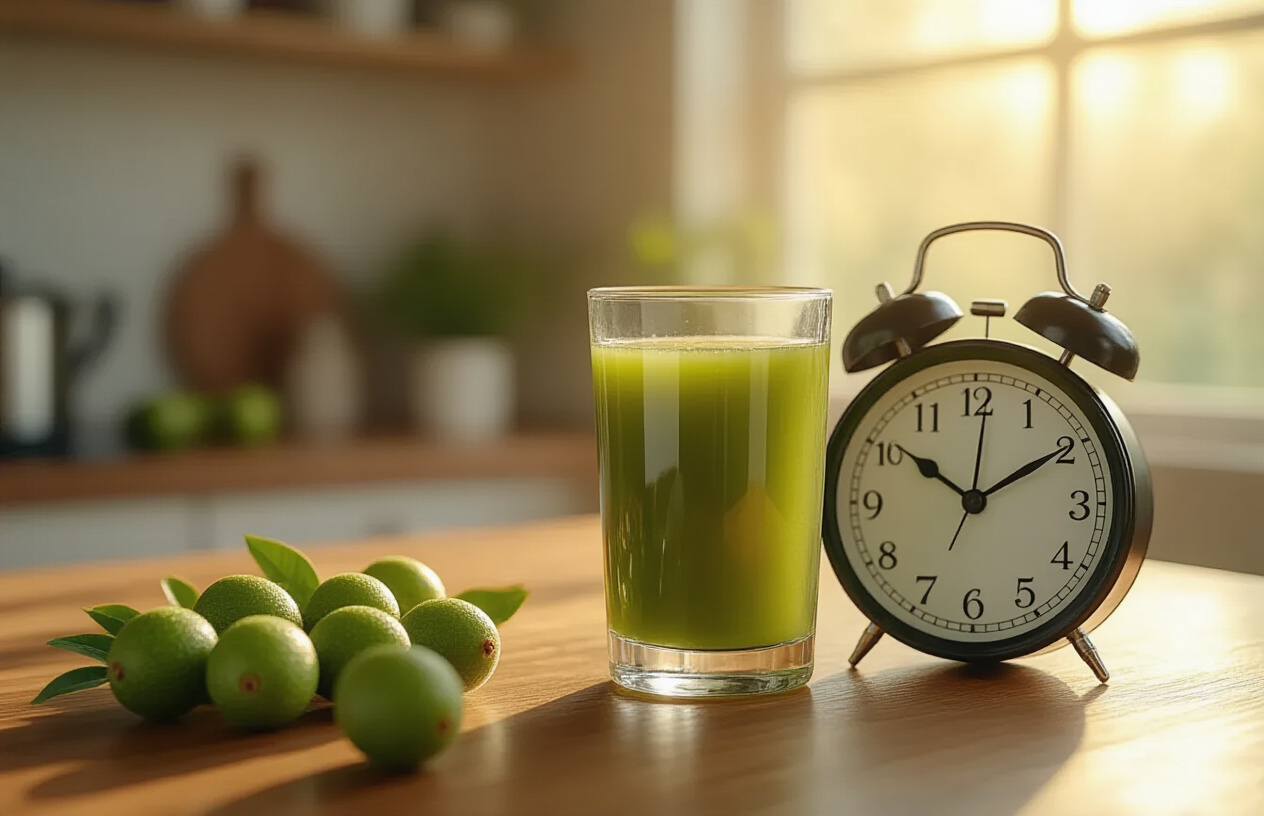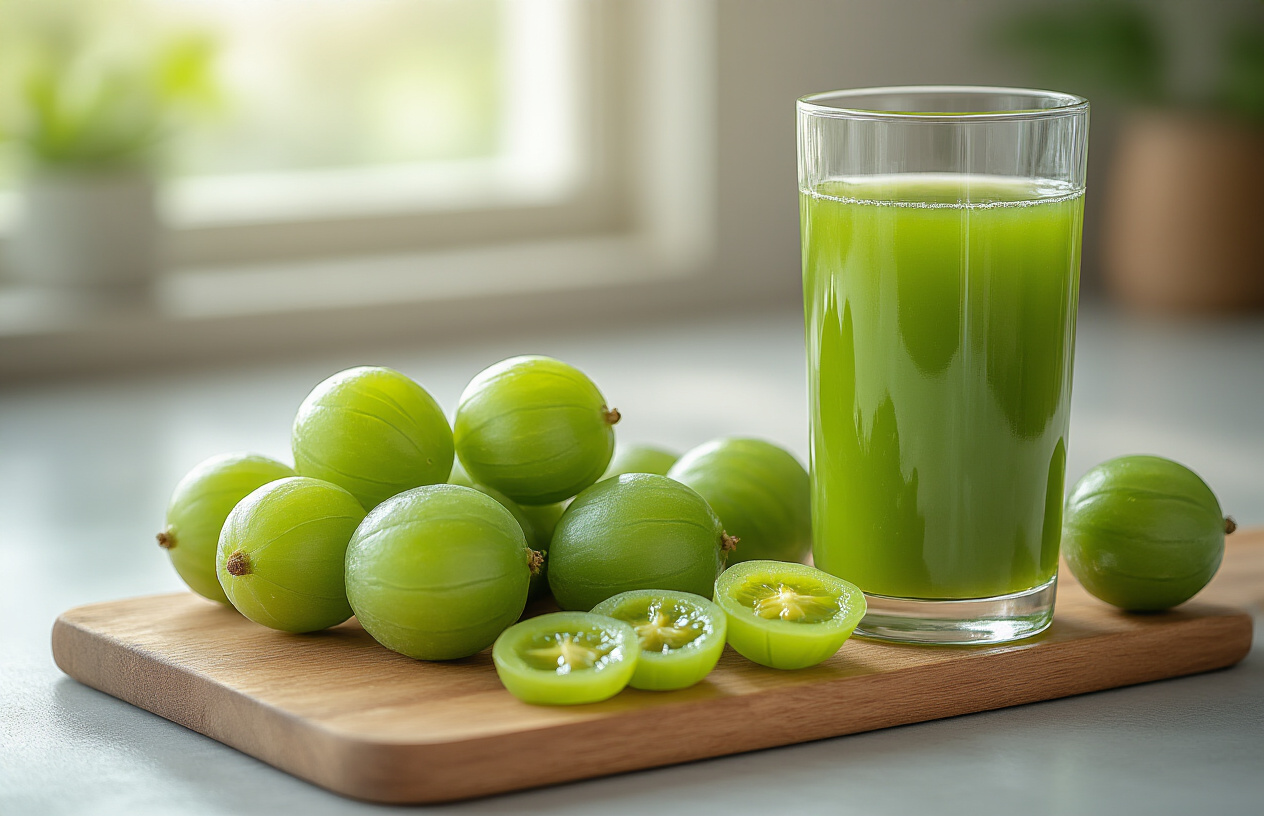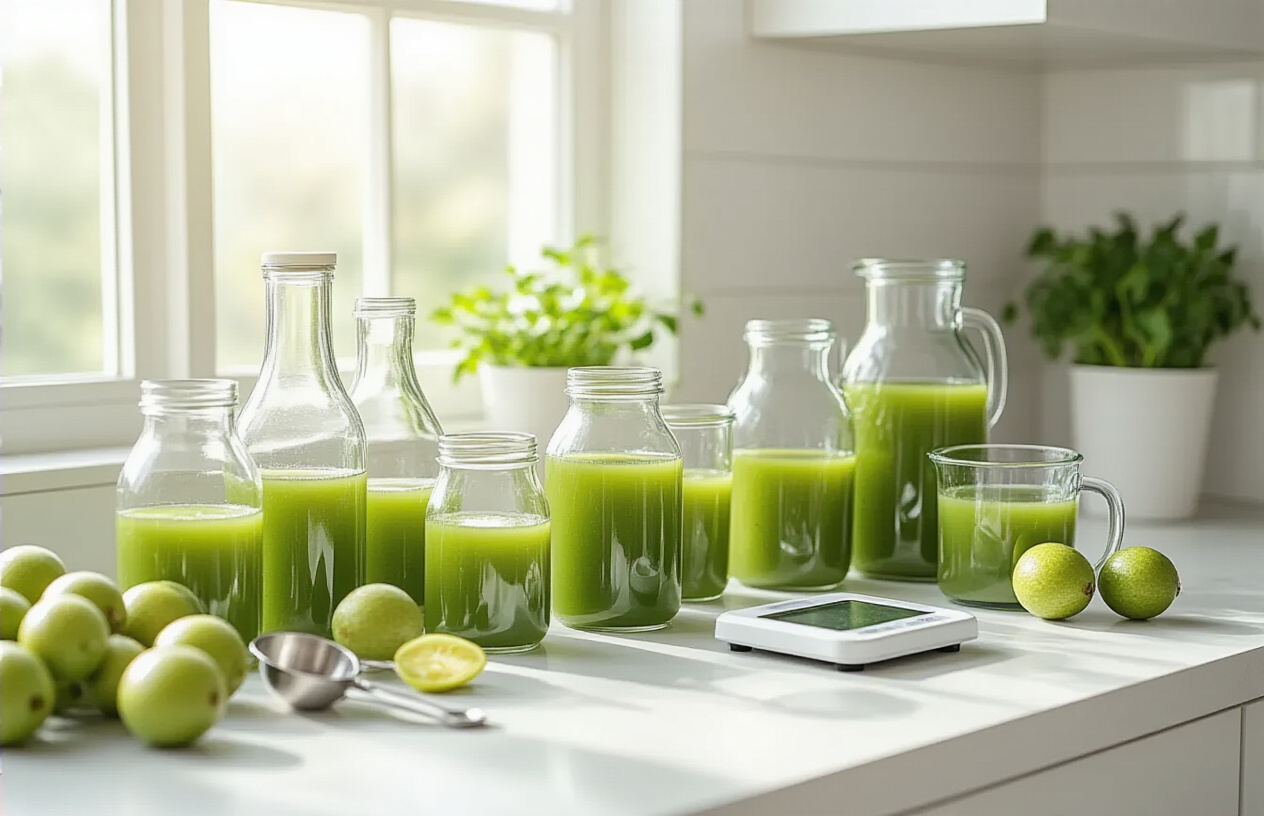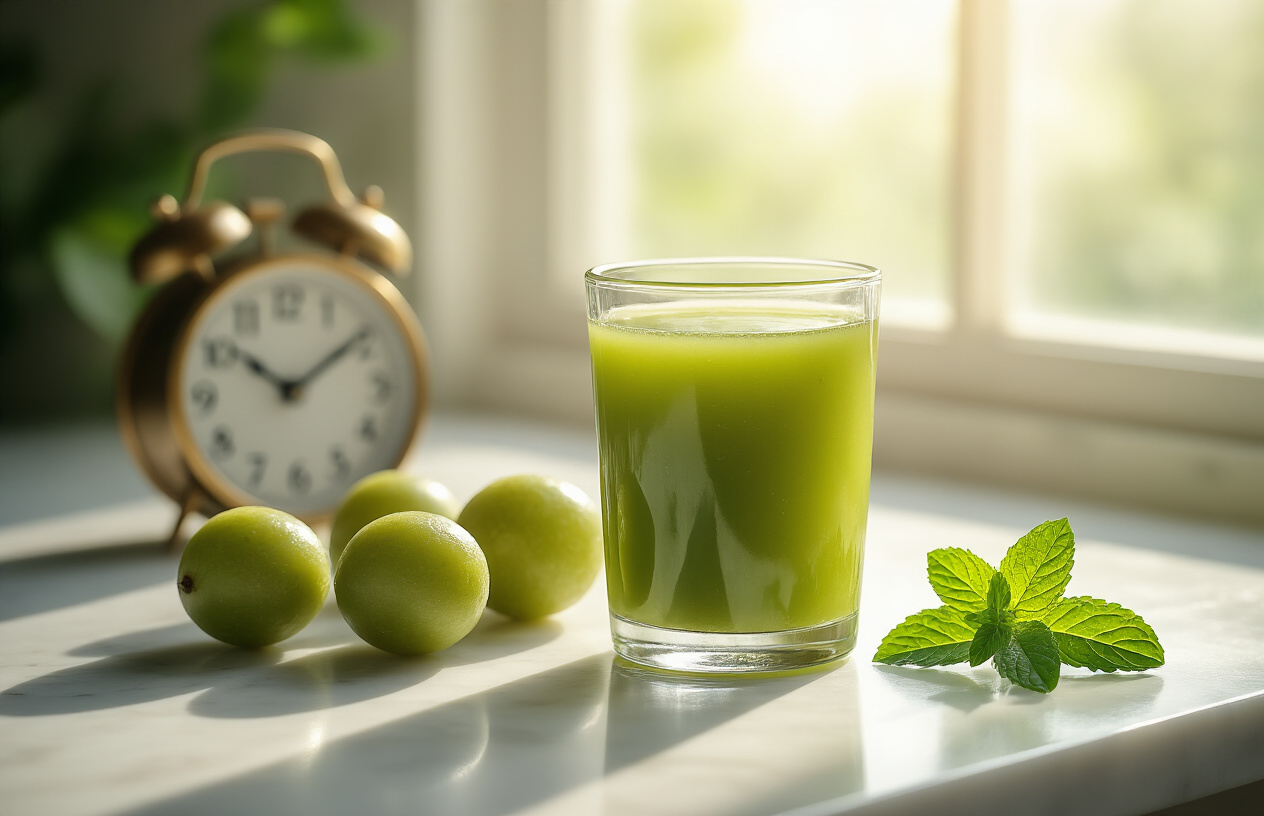Amla juice has become a popular health drink, but drinking it at the wrong time can reduce its powerful benefits. This guide is perfect for health-conscious individuals, fitness enthusiasts, and anyone looking to add this vitamin C powerhouse to their daily routine.
Many people wonder about the amla juice best time to drink and struggle with questions like whether to have it on an empty stomach or with meals. Getting the timing right makes all the difference in how your body absorbs and uses amla’s nutrients.
We’ll explore the optimal timing for maximum absorption, breaking down why morning consumption often works best and what science says about amla juice timing. You’ll also discover the impressive health benefits of regular amla juice consumption, from boosting immunity to supporting healthy skin and hair. Finally, we’ll cover proper dosage guidelines so you know exactly how much to drink based on your specific health goals.
Optimal Timing for Maximum Amla Juice Absorption

Early Morning on Empty Stomach Benefits
Starting your day with amla juice on an empty stomach delivers the most powerful nutritional punch. Your digestive system is at its cleanest state after the overnight fast, allowing for maximum vitamin C absorption. The acidic nature of amla juice stimulates digestive enzymes and kickstarts your metabolism for the entire day.
When to drink amla juice in the morning becomes crucial – aim for 30-45 minutes before your first meal. This timing ensures the concentrated nutrients don’t compete with other foods for absorption. Your body’s natural cortisol levels are also elevated in the morning, making it the ideal time for your system to process and utilize amla’s antioxidants effectively.
Morning consumption helps regulate blood sugar levels throughout the day, particularly beneficial for people with diabetes or pre-diabetic conditions. The natural pectin in amla juice creates a protective lining in your stomach, preparing it for the day’s meals while providing sustained energy without sugar spikes.
Pre-Meal Consumption for Digestive Enhancement
Taking amla juice 15-20 minutes before meals transforms your digestive experience. The natural enzymes in amla juice prepare your stomach by increasing gastric acid production, which breaks down proteins more efficiently and enhances nutrient absorption from your food.
This pre-meal timing is especially effective for people who struggle with indigestion, bloating, or slow metabolism. The fiber content in fresh amla juice helps create a feeling of satiety, naturally reducing portion sizes and supporting weight management goals.
Amla juice benefits for digestion include stimulating bile production, which is essential for fat digestion. The tannins present in amla help strengthen the digestive tract lining and reduce inflammation in the gut. This makes it particularly valuable for people with sensitive stomachs or those recovering from digestive disorders.
For optimal results, dilute your amla juice with equal parts water when consuming before meals to prevent any potential stomach irritation while maintaining its digestive benefits.
Post-Workout Recovery Window
Best time for amla juice consumption after exercise falls within the 30-60 minute post-workout window. During this period, your muscles are primed to absorb nutrients for repair and recovery. Amla’s high vitamin C content supports collagen synthesis, which is crucial for muscle and connective tissue repair.
The natural electrolytes in amla juice help restore mineral balance lost through sweat, while its anti-inflammatory properties reduce exercise-induced oxidative stress. Unlike commercial sports drinks loaded with artificial sugars, amla juice provides clean, natural energy that doesn’t cause insulin spikes.
Amla juice dosage for post-workout recovery should be around 30-50ml mixed with water or coconut water for additional hydration benefits. The combination creates an excellent natural recovery drink that supports muscle protein synthesis and reduces recovery time between training sessions.
Athletes and fitness enthusiasts often report improved energy levels and faster recovery when incorporating amla juice into their post-exercise routine compared to synthetic supplements.
Evening Intake Considerations
Amla juice morning or evening consumption depends on your specific health goals and lifestyle. Evening intake can be beneficial for people who experience acid reflux or heartburn after dinner, as amla’s alkalizing properties help neutralize stomach acid naturally.
However, evening consumption requires careful timing. Taking amla juice 2-3 hours before bedtime prevents potential sleep disruption from its energizing vitamin C content. Some people find that evening amla juice consumption helps with overnight detoxification processes, supporting liver function during the body’s natural cleansing cycle.
When to drink amla juice in the evening should align with your dinner schedule – either 30 minutes before your evening meal to aid digestion or 2-3 hours after to help with nutrient processing. The antioxidants work overnight to repair cellular damage accumulated throughout the day.
People with sensitive stomachs might experience mild acidity if consuming amla juice too close to bedtime, so testing your individual tolerance is important. Start with smaller doses in the evening and gradually adjust based on how your body responds to find your optimal amla juice timing.
Scientific Evidence Behind Timing Recommendations

Nutrient Absorption Patterns Throughout the Day
Your body’s ability to absorb nutrients changes dramatically throughout the day, making when to drink amla juice a crucial factor for maximizing its benefits. Research shows that nutrient absorption peaks during specific hours, with the morning period offering optimal conditions for vitamin C uptake.
During the early morning hours (6 AM to 10 AM), your digestive system operates at its highest efficiency. Gastric emptying rates are faster, and intestinal transporters responsible for vitamin C absorption are more active. This explains why amla juice empty stomach consumption has gained popularity among health enthusiasts.
Studies indicate that water-soluble vitamins like vitamin C, which makes up 80% of amla’s beneficial compounds, are absorbed most effectively when the stomach is empty. The absence of competing nutrients allows for direct contact with intestinal walls, enabling maximum uptake through sodium-dependent vitamin C transporters.
The afternoon period (12 PM to 3 PM) presents a secondary absorption window, though less efficient than morning hours. Evening consumption shows reduced bioavailability due to slower gastric motility and competing digestive processes from meals.
Timing also affects the distribution of nutrients to different organs. Morning consumption ensures that vitamin C reaches the liver during its peak detoxification phase, while also supporting adrenal gland function when cortisol levels naturally rise.
Stomach Acid Levels and Vitamin C Uptake
Stomach acid production follows a predictable daily pattern that directly impacts amla juice timing effectiveness. Your gastric pH levels fluctuate between 1.5 and 3.5 throughout the day, with the lowest (most acidic) levels occurring in the early morning after an overnight fast.
Vitamin C requires specific pH conditions for optimal absorption. The acidic environment in the morning enhances the reduction of vitamin C from its oxidized form, making it more bioavailable. This chemical process is essential because only the reduced form can be transported across intestinal membranes.
When you drink amla juice on an empty stomach, gastric acid levels remain concentrated, creating ideal conditions for vitamin C solubility. Research demonstrates that absorption rates can be up to 40% higher when consumed during low-pH periods compared to post-meal consumption.
Food intake significantly alters stomach pH, often raising it to 4.0 or higher. This alkaline shift reduces vitamin C stability and can lead to oxidation before absorption occurs. Proteins and fats particularly interfere with vitamin C uptake, competing for transport mechanisms and creating binding complexes that hinder absorption.
The best time for amla juice consumption aligns with natural acid production cycles. Clinical studies show that consuming vitamin C-rich foods during peak acid periods results in higher plasma concentrations and better cellular uptake compared to random timing.
Circadian Rhythm Impact on Metabolism
Your internal biological clock controls more than just sleep patterns – it orchestrates metabolic processes that determine how effectively your body processes amla juice benefits. Circadian rhythms regulate enzyme production, hormone release, and cellular repair mechanisms, all of which influence nutrient utilization.
The morning cortisol surge, peaking between 6-8 AM, triggers metabolic pathways that enhance vitamin C metabolism. This natural hormone boost increases cellular energy production and supports the conversion of vitamin C into its active forms. Drinking amla juice during this window takes advantage of your body’s heightened metabolic state.
Liver detoxification follows a circadian pattern, with Phase I and Phase II detox processes most active during early morning hours. Amla’s antioxidants support these natural cleansing cycles, but only when consumed at optimal times. Evening consumption may actually disrupt sleep patterns due to increased metabolic activity when your body expects to rest.
Insulin sensitivity also varies throughout the day, affecting how your body processes the natural sugars in amla juice. Morning consumption occurs when insulin sensitivity is highest, preventing blood sugar spikes and ensuring steady energy release.
Research on chronotherapy (time-based treatment) shows that antioxidant supplements provide greater protection against oxidative stress when consumed in alignment with circadian rhythms. The amla juice morning or evening debate is settled by understanding that morning consumption synchronizes with your body’s natural repair and regeneration cycles.
Temperature regulation, controlled by circadian rhythms, also affects absorption. Morning consumption supports the natural temperature rise that accompanies waking, while evening intake may interfere with the cooling process necessary for quality sleep.
Health Benefits of Regular Amla Juice Consumption

Immune System Strengthening Properties
Amla juice packs an incredible vitamin C punch – we’re talking about 20 times more vitamin C than oranges. This massive vitamin C content makes your immune system stronger and better equipped to fight off infections. The amla juice health benefits for immunity go beyond just vitamin C though. The juice contains powerful compounds called polyphenols that help white blood cells work more effectively.
Research shows that people who drink amla juice regularly experience fewer seasonal illnesses. The natural antibacterial and antiviral properties help your body create a protective barrier against harmful pathogens. Your immune response becomes quicker and more targeted when you maintain consistent amla juice daily intake.
Antioxidant Protection Against Free Radicals
Free radicals cause cellular damage that leads to premature aging and chronic diseases. Amla juice acts like a shield, neutralizing these harmful molecules before they can wreak havoc on your body. The antioxidant power comes from a unique combination of vitamin C, tannins, and flavonoids working together.
Studies reveal that regular amla juice consumption can reduce oxidative stress markers by up to 40%. This protection extends to every cell in your body, from your brain to your heart. The anthocyanins in amla juice specifically target inflammatory pathways, creating a comprehensive defense system against cellular damage.
Digestive Health and Gut Function Improvement
Your digestive system gets a major boost from amla juice’s natural enzymes and fiber content. The juice stimulates the production of digestive juices, making it easier to break down food and absorb nutrients. Many people notice less bloating and improved bowel movements within weeks of starting regular consumption.
The prebiotic properties of amla juice feed beneficial gut bacteria, creating a healthier microbiome balance. This improved gut health translates to better nutrient absorption, stronger immunity, and even improved mood through the gut-brain connection. The natural acidity helps maintain optimal stomach pH levels for proper digestion.
Skin and Hair Health Enhancement
Amla juice works from the inside out to give you healthier skin and stronger hair. The high vitamin C content supports collagen production, which keeps your skin firm and reduces fine lines. People often report a natural glow appearing after several weeks of consistent use.
For hair health, amla juice strengthens follicles and reduces premature graying. The antioxidants protect hair from environmental damage while the nutrients nourish the scalp. Many users experience less hair fall and improved hair texture. The anti-inflammatory properties also help with scalp conditions like dandruff.
Blood Sugar Regulation Support
Amla juice contains chromium and other compounds that help regulate blood glucose levels. The fiber slows down sugar absorption, preventing those energy crashes that come after meals. This makes it particularly beneficial for people managing diabetes or prediabetes.
The polyphenols in amla juice improve insulin sensitivity, helping your cells use glucose more effectively. Regular consumption can lead to more stable energy levels throughout the day. Studies show that drinking amla juice before meals can reduce post-meal blood sugar spikes by up to 30%.
Dosage Guidelines for Different Health Goals

General Wellness Maintenance Amounts
For maintaining general health and supporting your immune system, 20-30ml of amla juice daily intake works perfectly for most adults. This amount provides your body with a steady supply of vitamin C and antioxidants without overwhelming your digestive system. You can start with 15ml if you’re new to drinking amla juice and gradually increase the dosage over a week.
Many people find success dividing this amount into two servings – 15ml in the morning on an empty stomach and another 15ml in the evening before dinner. This approach helps maintain consistent vitamin C levels throughout the day and supports better absorption.
For those who prefer a simpler routine, taking the full 30ml dose first thing in the morning works just as well. Mix it with an equal amount of water to reduce the tartness and make it more palatable for daily consumption.
Therapeutic Doses for Specific Conditions
Different health conditions require adjusted amla juice dosage for optimal results:
| Condition | Recommended Dose | Timing | Duration |
|---|---|---|---|
| High cholesterol | 30-40ml twice daily | Morning empty stomach, evening before meals | 3-6 months |
| Diabetes management | 20ml twice daily | 30 minutes before meals | Ongoing with doctor supervision |
| Hair loss/premature graying | 30ml daily + topical application | Morning empty stomach | 6-12 months |
| Digestive issues | 15-20ml twice daily | Before main meals | 2-3 months |
| Cold and flu prevention | 40-50ml daily | Morning on empty stomach | During flu season |
People dealing with chronic conditions should always consult their healthcare provider before starting higher therapeutic doses. Some medications can interact with large amounts of vitamin C, so professional guidance becomes essential.
Age-Specific Consumption Recommendations
Children (5-12 years): Start with 5-10ml daily, mixed with honey or fresh fruit juice to improve taste. Their developing digestive systems need gentler amounts, and the natural tartness of amla can be too intense for young palates.
Teenagers (13-18 years): 15-20ml daily works well for supporting growth and boosting immunity during school years. This age group often benefits from taking amla juice in the morning before breakfast to help with concentration and energy levels.
Adults (19-60 years): The standard 20-30ml daily serves this group well for general wellness. Active adults or those under high stress can safely increase to 40ml daily, split into morning and evening doses.
Seniors (60+ years): 15-25ml daily provides excellent antioxidant support for aging bodies. Older adults should start with smaller amounts since their digestive systems may be more sensitive. Taking it with a small snack can help prevent any stomach discomfort.
Pregnant and breastfeeding women should limit intake to 15ml daily and consult their doctor first, as high doses of vitamin C can sometimes cause complications during pregnancy.
Common Timing Mistakes to Avoid

Taking with Medications That Reduce Effectiveness
Timing your amla juice consumption around certain medications can significantly impact both the juice’s benefits and your medication’s effectiveness. Blood-thinning medications like warfarin can interact with amla’s high vitamin C content, potentially altering clotting times. If you’re taking diabetes medications, drinking amla juice too close to your medication schedule might cause unexpected blood sugar fluctuations since amla naturally helps regulate glucose levels.
Iron supplements present another common conflict. The vitamin C in amla actually enhances iron absorption, which might sound beneficial but can lead to iron overload if you’re already taking prescribed iron supplements. Always maintain at least a 2-hour gap between amla juice and iron medications unless your doctor advises otherwise.
Blood pressure medications require special attention too. Since amla juice can naturally lower blood pressure, consuming it immediately before or after your prescribed medication might cause your pressure to drop too low, leading to dizziness or fainting.
Consuming Too Close to Bedtime
Drinking amla juice late in the evening or close to bedtime disrupts your natural sleep patterns and reduces the juice’s effectiveness. The high vitamin C content acts as a mild stimulant, potentially keeping you alert when you should be winding down for sleep.
Your body’s metabolism slows significantly during evening hours, meaning the nutrients in amla juice won’t be absorbed as efficiently compared to morning consumption. The best time for amla juice consumption remains early morning on an empty stomach, allowing maximum nutrient absorption throughout your active day.
Late-night consumption can also trigger acid reflux in sensitive individuals. Amla’s natural acidity, while beneficial during daytime digestion, can cause discomfort when you’re lying down, making sleep difficult and reducing the juice’s health benefits.
Mixing with Incompatible Foods and Beverages
Certain food combinations can neutralize amla juice’s powerful antioxidants and reduce its health benefits. Dairy products create the most problematic combination – the proteins in milk can bind with amla’s tannins, reducing both nutrient absorption and effectiveness.
Caffeinated beverages like coffee or tea should be avoided within 30 minutes of drinking amla juice. Caffeine interferes with vitamin C absorption and can cause stomach irritation when combined with amla’s natural acidity.
Processed foods high in preservatives and artificial additives counteract amla’s detoxifying properties. The chemicals in processed foods force your liver to work harder, reducing its ability to process amla’s beneficial compounds effectively.
| Avoid Mixing With | Waiting Period | Reason |
|---|---|---|
| Dairy products | 1-2 hours | Protein interference |
| Coffee/Tea | 30-60 minutes | Caffeine blocks absorption |
| Iron-rich foods | 2 hours | May cause overload |
| Processed foods | 1 hour | Chemical interference |
Citrus fruits might seem compatible, but combining multiple high-acid sources can overwhelm your digestive system and cause stomach upset, especially when consuming amla juice on an empty stomach in the morning.

The timing of your amla juice consumption really does make a difference in how well your body absorbs its nutrients. Based on scientific research, drinking it on an empty stomach in the morning gives you the best results, though you can also benefit from having it before meals or post-workout. The key is staying consistent with whatever timing works for your lifestyle and avoiding common mistakes like drinking it right after heavy meals or mixing it with incompatible foods.
Regular amla juice consumption brings impressive health benefits, from boosting your immune system to improving digestion and supporting healthy skin. Start with smaller doses and gradually increase based on your specific health goals, whether that’s general wellness or targeting particular concerns. Remember to listen to your body and adjust your routine as needed – the best timing is ultimately the one you can stick with long-term for maximum health benefits.









